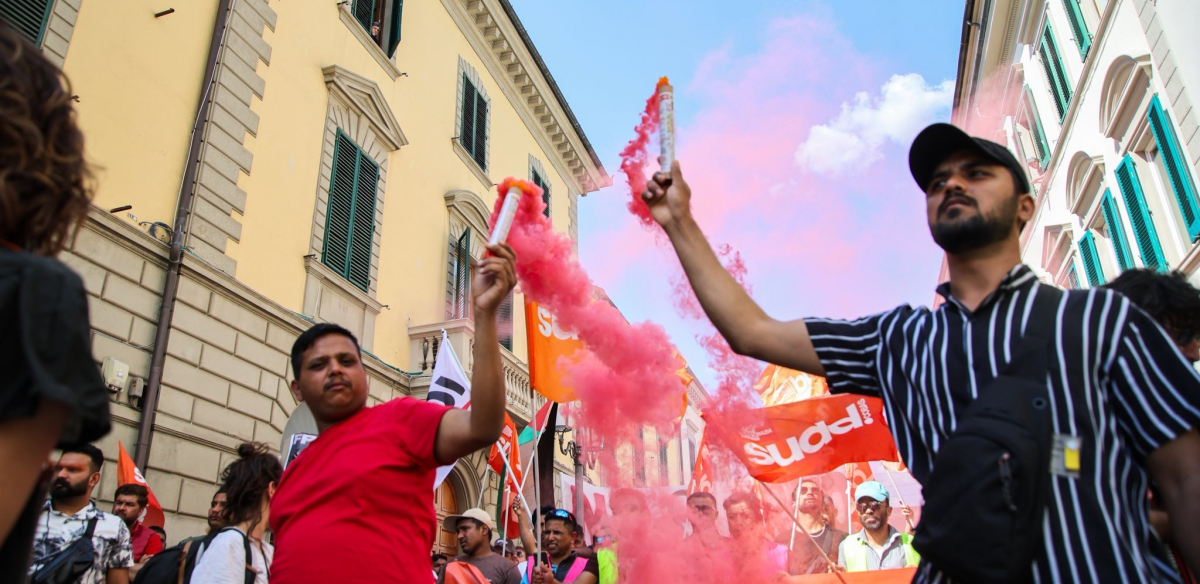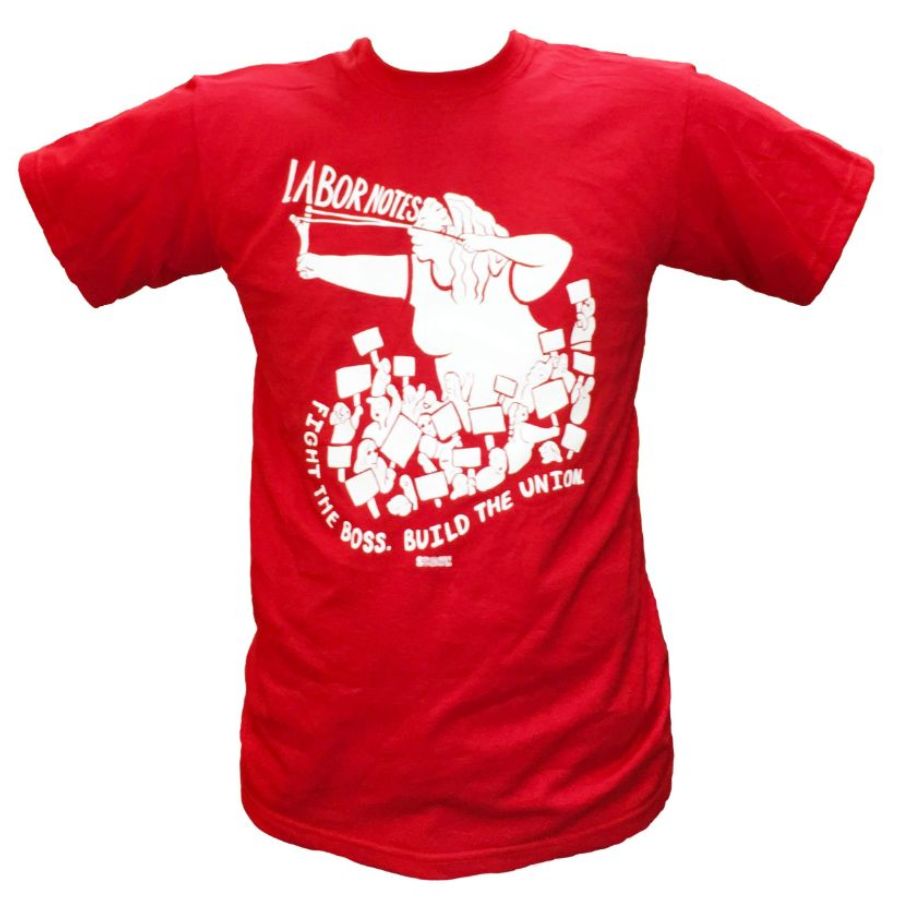In Italy, Immigrant Workers Launch a Wave of Strikes for a 40-Hour Week

The Italian city of Prato is a hub of world-famous “Made in Italy” fashion. The city hosts over 7,000 textile and garment companies, employing 43,000 workers—and has become notorious for its exploitative labor conditions. Photo: SUDD Cobas
Since early April, immigrant workers in the Tuscan city of Prato have staged a wave of strikes demanding their right to a 40-hour work week, or “8x5.”
Organized by the union SUDD Cobas, these walkouts, dubbed “Strike Days,” have directly involved 70 textile and garment factories in Europe’s biggest textile manufacturing hub. Highly successful, these simultaneous strikes have now won “8x5”—eight hour days, five days a week—in 68 fashion workshops and warehouses, all within the span of 14 weeks.
These victories are the result of seven years of organizing in one of Italy’s most infamous industrial zones. Prato is estimated to host over 7,000 textile and garment companies, employing 43,000 people. Workers are typically hired by small companies engaged in distinct phases of fashion production—specializing in dying thread, twisting yarn, printing fabric, sewing T-shirts, or even moving hangers between establishments. Together, these activities generate almost two billion euros in annual export revenue, making Prato an important hub of world-famous “Made in Italy” fashion.
In Italy, however, the city is renowned for both its high presence of immigrant workers and its exploitative labour conditions, including 14-hour workdays, union busting, dangerous machinery, and makeshift dormitories inside workshops that led to the deaths of seven Chinese workers in a 2013 factory fire.
For years, this infamy brought a slew of journalists and scholars to the city, including myself. Today, familiar videos of workers at sewing machines circulate alongside images of marches and picketlines as the city has become the scene of an upsurge of immigrant labor militancy. Union organizers at SUDD Cobas call this upsurge the “8x5 movement,” tracing its inauguration back to the 2021 Texprint strike (which I wrote about for Labor Notes at the time); a nine-month strike at a fabric printing company aimed at winning a 40-hour week.
It was at Texprint that I first encountered the union, and I, like many others, found myself called into their struggle. Their bravery and humour was infectious, and I watched in awe as picketers held a 24/7 blockade to prevent the circulation of trucks at the factory gate, even as they faced months of fines, violence, arrests, and harsh weather.
SUDD Cobas is famous for these permanent blockades. Picketers eat, sleep, and hang out at the presidio, the term used by SUDD Cobas members to refer to the infrastructure of tents, tables, chairs, and gazebos erected to support everyday life at the picket line. Typically denoting guardianship or garrison in Italian, the presidio and its inhabitants ensure that finished goods cannot exit workplaces. The presidio allows the strike to hit the company’s bottom line regardless of the strike’s numerical strength; some of the strikes have been minority strikes. These financial repercussions and the threat of client loss eventually get many employers to the table.
SUDD Cobas was formed in May 2024 after a split from the independent union Si Cobas. SUDD is an acronym for Sindacato Unione Democrazia Dignità—the Unity, Democracy, Dignity Union—while Cobas refers to the many comitati di base (“base committees”) that populate Italy’s industrial landscape. Base unions like SUDD Cobas operate outside of the country’s three main labor confederations (the CGIL, CISL, and UIL), historically tied to different political parties. In Prato, SUDD Cobas has clashed with both employers and elected officials from the center-left Democratic Party as it demands rights for some of the city’s most marginalized workers.
The Strike Days model launched this spring is a new organizing model for the union: simultaneous, unlimited strikes with permanent picket lines across multiple companies, coordinated by geographic zone. Last week, I sat down with Sarah Caudiero, a coordinator of SUDD Cobas, to talk about the union’s experiment.
Morganne: First, can you explain what led to Strike Days?
Sarah: Beginning on April 6, we ran a month of indefinite strikes in the form of a relay. Each had a presidio. Bosses wouldn’t know who was next. We’d start a strike, and when that one ended, we’d begin a new one elsewhere, moving the presidio each time.
Morganne: Your relay model sounds similar to the United Auto Workers’ Stand-Up model, recently used in the 2023 Big Three contract strikes and my own local’s strike last year at the University of California in solidarity with pro-Palestinian protesters. In those strikes, the union didn’t take everyone out on strike at once, but instead called out new factories or campuses over time, keeping the boss guessing. How successful was this model in Prato?
Sarah: Very. Many of the strikes ended up being very short; one day of striking could be sufficient to win a contract. In total, we held 15 strikes in one month. In fact, it went so well we had to make changes to the model. Many workers came to us and asked us to help them organize a strike in their workplace. Had we continued with the relay model, we would have run out of time. The high season of fashion production—April to July—would have ended, and we would have lost significant leverage.
Morganne: That’s when you turned to the Strike Days model.
Sarah: Correct. We started holding our first set of Strike Days on May 30. We no longer ran strikes as a relay but ran them simultaneously from the get-go. The maximum we held at any one time was 10 strikes for four days. When one strike ended, another would start. So, for example, on a Friday we could have 10 strikes that morning but two would end by the afternoon, with two new ones starting that evening.

SUPPORT LABOR NOTES
BECOME A MONTHLY DONOR
Give $10 a month or more and get our "Fight the Boss, Build the Union" T-shirt.
This maximum was set by our own capacities. Each presidio needs to have at least one person who can speak sufficient Italian in case the cops arrive or in case the boss communicates their willingness to come to the table. These point-persons typically were active in the union prior to the strike at hand—they have gone to “Know Your Rights” workshops, they have gone to union-wide assemblies, and they know who to contact in the union to coordinate negotiations or organize an emergency response to threats of violence.
One the first Sunday of Strike Days, we held what we called a Macroblocco Day [a play-on-words of Macrolotto, the name for Prato’s industrial zones, with “lotto” replaced by “blocco,” Italian for blockade]. We had 10 picket lines set up in the exploitative heart of the Macrolotto and held a march through its streets. The march involved mostly union workers from Pakistan, Bangladesh, Afghanistan, and India, but also involved high schoolers, undergraduate students, and activists from the nearby cities of Pisa and Lucca.
We started from Teresa Moda, the factory where seven workers were killed in the 2013 fire. And as we walked along, workers would leave their workplaces to join the march. This had all been secretly organized ahead of time, of course.
Morganne: I have shivers!
Sarah: It was incredible! One worker we didn’t know—he was employed at a neighboring factory—even left his workplace! By that evening, only three picket lines remained. All the other strikes had been won!
The next day, while we were at one of those three picket lines, a worker at a neighboring company told us he wanted to go on strike. So, we helped him organize a strike. Inspired, union members took a megaphone and started shouting into the streets that all workers could go on strike. Eight workers from four garment companies spontaneously left their work and joined us on the street.
It’s important to note that this was only possible because the workers who struck in April and won their rights joined the newcomers in a solidarity strike during the Strike Days. Sustaining this many simultaneous strikes requires tremendous support—and these workers provided it.
Morganne: What is the union up to now?
Sarah: We’ve now launched a new round of Strike Days. Since the last round, workers from 30 additional factories have approached us for help coordinating strikes. So far, we’ve carried out 18 strikes in this new wave and are currently finalizing the fifteenth contract.
Morganne: What lessons have you drawn from this experience with Strike Days?
Sarah: The importance of organizing picket line support by geographic zone. We divided Prato into eight zones. Workers who had already won 8x5 held zone meetings to organize night shifts, food preparation, and water logistics. Keeping picketers hydrated is difficult in an industrial zone, but it’s crucial, especially given the scalding temperatures we are experiencing in Italy. People who had not previously been very active in the union were activated as the need for mass support was crystal clear.
Morganne: We live in a moment in which the numerical size of a strike is often held as yardstick of its historical (in)significance. One might look at these numbers and say, “Well, what’s the big deal if a few dozen tiny workplaces unionize?” Can you explain the importance of these Strike Days?
Sarah: Strike Days involve strikes in very small textile and garment companies—places that have long been considered impossible to unionize because of how few workers they employ. Sewing workshops, ironing workshops, ready-to-wear warehouses… We are talking about eight to 20 people in any workplace. Consequently, these companies often have the worst working conditions. Twelve-hour days, seven days a week.
But their bosses are not “small bosses”—they often own multiple companies. At SUDD Cobas, we think of these small companies as departments of one big factory and we organized these recent strikes accordingly. This focus on small workplaces was new to us. For six years, we had been organizing strikes in much larger textile manufacturing and garment logistics firms, each employing 50 to 100 workers. The smaller shops—of which there are countless in Prato—had been largely left out. As our union grew, the leadership set a new goal: to organize these seemingly impossible-to-unionize spaces. We did so through solidarity—by organizing workers from different companies as if they were colleagues. Workers who had gone on strike years earlier in the bigger factories showed up to support the picket lines in their geographic zones. Without their support, none of the recent Strike Days victories would have been possible.
The success of Strike Days is significant because we showed that the impossible can be made possible through solidarity.




